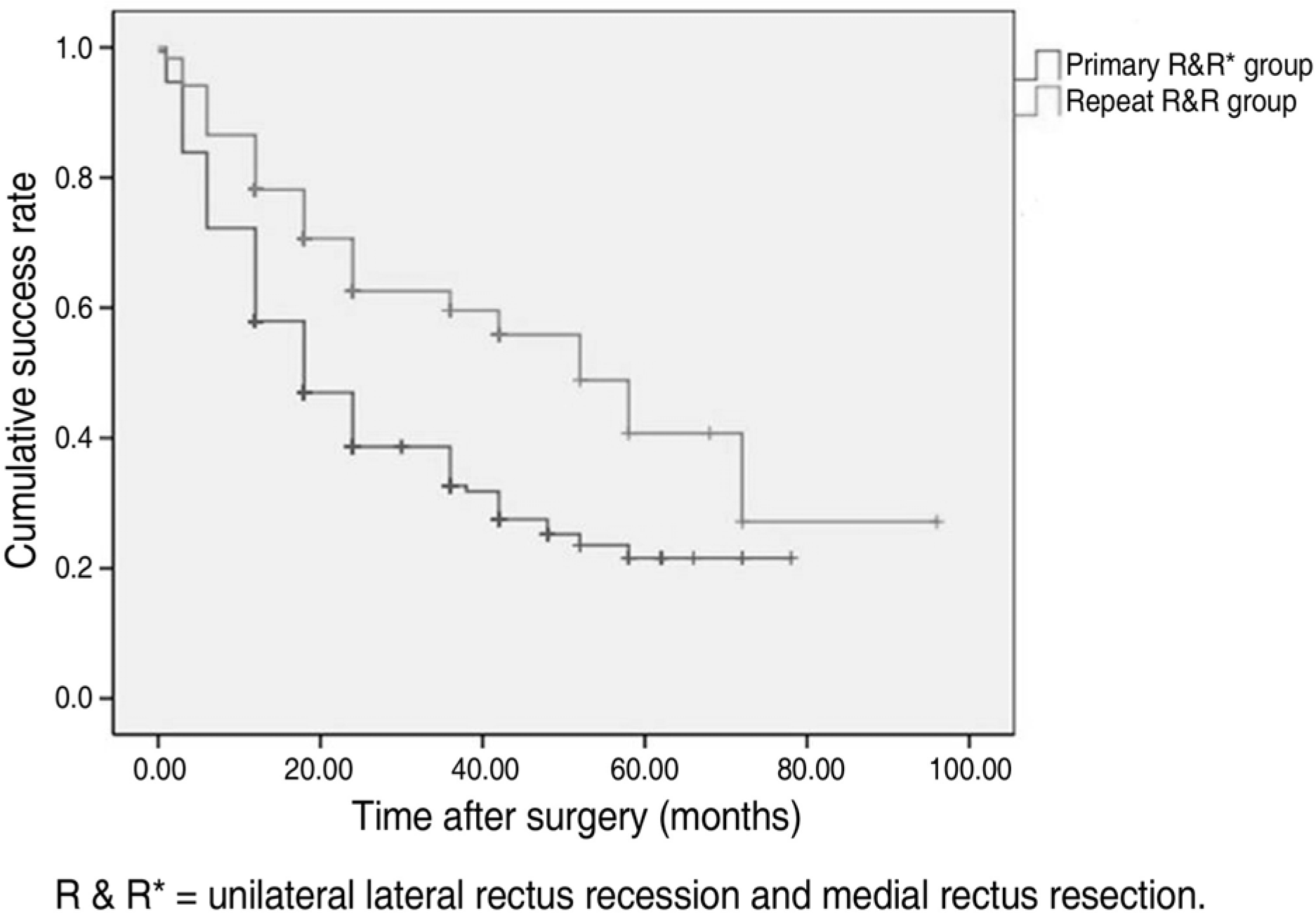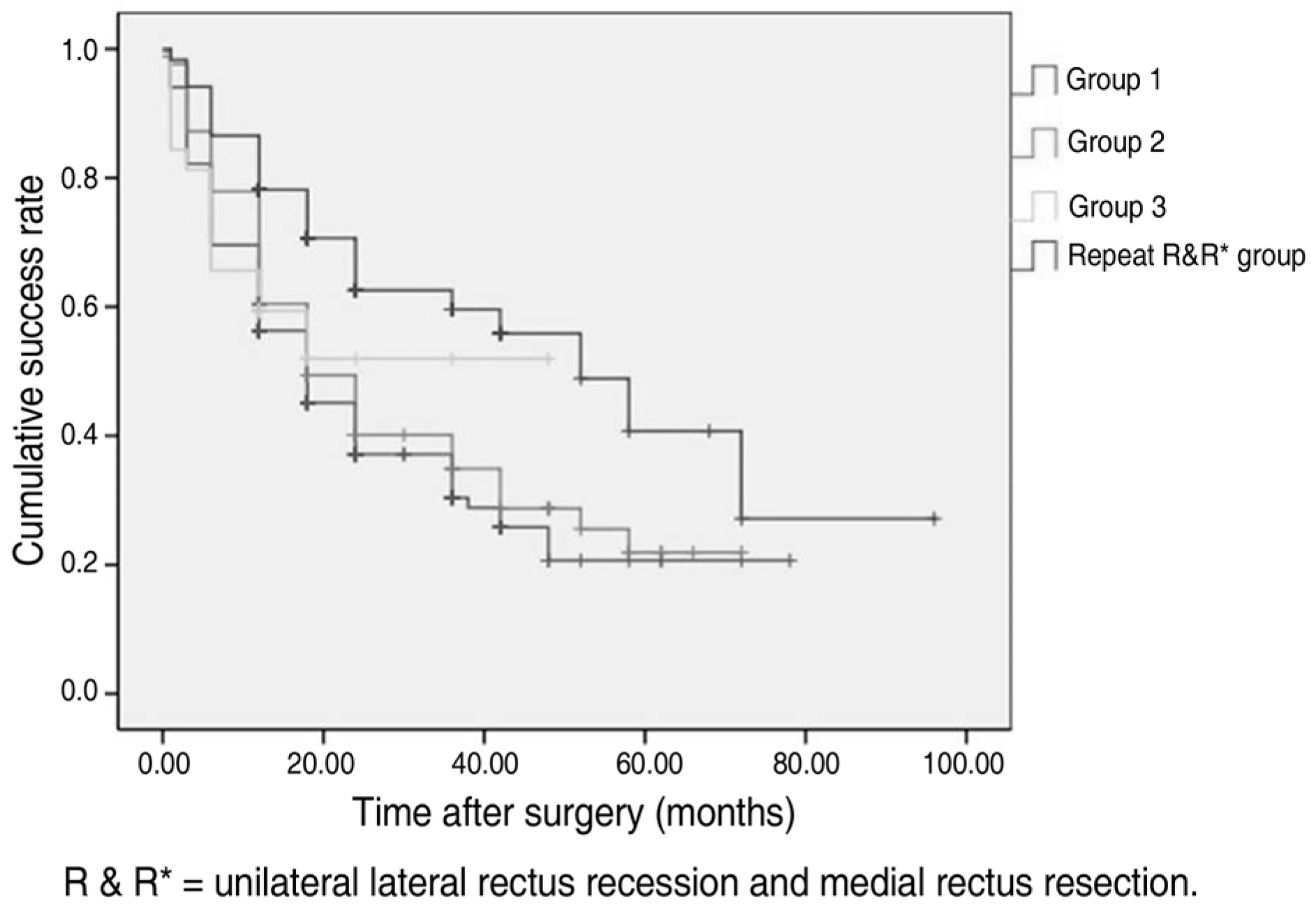Abstract
Purpose
To investigate the clinical course of recess-resection (R & R) on the contralateral eye for recurrent intermittent exotropia after previous unilateral R & R surgery.
Methods
A retrospective analysis was conducted on patients who had unilateral R & R surgery and patients who had a second R & R surgery on the contralateral eye for recurrent intermittent exotropia with at least 12 months of postoperative followup.
References
1. Figueira EC, Hing S. Intermittent exotropia: comparison of treatments. Clin Experiment Ophthalmol. 2006; 34:245–51.

2. Chia A, Seenyen L, Long QB. Surgical experiences with two- muscle surgery for the treatment of intermittent exotropia. J AAPOS. 2006; 10:206–11.
3. Jeoung JW, Lee MJ, Hwang JM. Bilateral lateral rectus recession versus unilateral recess-resect procedure for exotropia with a dominant eye. Am J Ophthalmol. 2006; 141:683–8.

4. Fiorelli VM, Goldchmit M, Uesugui CF, Souza-Dias C. Intermittent exotropia: comparative surgical results of lateral recti- recession and monocular recess-resect. Arq Bras Oftalmol. 2007; 70:429–32.
5. Maruo T, Kubota N, Sakaue T, Usui C. Intermittent exotropia surgery in children: long term outcome regarding changes in binocular alignment. A Study of 666 Cases. Binocul Vis Strabismus Q. 2001; 16:265–70.
6. Oh JY, Hwang JM. Survival analysis of 365 patients with exotropia after surgery. Eye. 2006; 20:1268–72.

7. Kim MM, Cho ST. Long-term surgical results of intermittent exotropia. J Korean Ophthalmol Soc. 1994; 35:1321–6.
8. Chang BL. Operative results in exotropia. J Korean Ophthalmol Soc. 1983; 24:729–34.
9. Park JL, Son MH, Yun IH, Won IG. The clinical analysis of surgical methods in intermittent exotropia. J Korean Ophthalmol Soc. 2002; 43:526–32.
10. Hahm IR, Yoon SW, Baek SH, Kong SM. The clinical course of recurrent exotropia after reoperation for exodeviation. Korean J Ophthalmol. 2005; 19:140–4.

11. Kim SJ, Choi DG. The Clinical analysis after reoperation for recurrent intermittent exotropia. J Korean Ophthalmol Soc. 2007; 48:321–7.
12. Kim SJ. Comparison of surgical results between bilateral recession and unilateral recession-resection in intermittent exotropia. J Korean Ophthalmol Soc. 1992; 33:95–100.
13. Mun HJ, Kim MM. Comparison of surgical results between bilateral recession and unilateral recession-resection in 25PD intermittent exotropia. J Korean Ophthalmol Soc. 2002; 43:2202–7.
14. Im SK, Park SW, Park YG. Effects of bilateral lateral rectus recession and unilateral recession-resection in large angle exotropia. J Korean Ophthalmol Soc. 2004; 45:990–4.
15. Lee SY, Sim JH, Lee YC. Comparison of surgical results according to surgical methods in simulated divergence excess exotropia. J Korean Ophthalmol Soc. 2004; 45:614–9.
16. Jeong TS, You IC, Park SW, Park YG. Factor of surgical success with unilateral recessionand resection in intermittent exotropia. J Korean Ophthalmol Soc. 2006; 47:1987–92.
17. Lew HL, Lee JB, Kim TK. Comparison of surgical results between bilateral rectus muscle recessions and lateral rectus muscle recession and muscle rectus resection in exotropia. J Korean Ophthalmol Soc. 1995; 36:115–9.
18. Yang SW, Chang BL. Pathologic finding after recession and resection of extraocular muscles in rabbits. Korean J Ophthalmol. 1989; 3:75–9.
19. Koo NK, Lee YC, Lee SY. Clinical study for the undercorrection factor in intermittent exotropia. Korean J Ophthalmol. 2006; 20:182–7.

20. Roh JH, Paik HJ. Clinical study on factors associated with recurrence and reoperation in intermittent exotropia. J Korean Ophthalmol Soc. 2008; 49:1114–9.

21. Lee SY, Lee YC. Comparison of surgical results by initial postoperative alignment following bilateral lateral rectus recession and unilateral lateral rectus recession-medial rectus resection in inter-mittent exotropes. J Korean Ophthalmol Soc. 1999; 40:2604–10.
Figure 1.
Kaplan-Meier survival curve showing the cumulative probability of surgical success following primary R&R group and repeat R&R group. There were greater probabilities of success in repeat R&R group than in primary R&R group (p=0.000, log rank test).

Figure 2.
Comparison of cumulative probability of surgical success between group 1, group 2, group 3, and repeat R & R group (p=0.000, log rank test).

Table 1.
Characteristics of patients
| Primary R&R∗ group | Repeat R&R group | p-value | |
|---|---|---|---|
| No. of patient | 490 | 119 | - |
| Sex (male : female) | 223:267 | 46:73 | 0.177† |
| Mean age (years, mean± SD) | 8.87±6.15 (4∼27) | 8.40±3.43 (6∼27) | 0.265‡ |
| Preoperative deviation (PD§, mean± SD) | 32.56±6.3 | 27.71±3.78 | 0.000‡ |
| Postoperative deviation at 1 week (PD, mean± SD) | 0.4±4.7 | -0.4±5.4 | 0.115† |
Table 2.
Comparisons of cumulative probability of surgical success rate between primary R&R group and repeat R&R group
| Postoperative followup period |
No. of patients (success rate, %) |
|
|---|---|---|
| Primary R&R∗ group | Repeat R&R group | |
| 1 wk | 487/490 (99.4) | 119/119 (100) |
| 1 mo | 464/490 (94.7) | 117/119 (98.3) |
| 3 mo | 411/490 (83.9) | 112/119 (94.1) |
| 6 mo | 354/490 (72.7) | 103/119 (86.6) |
| 12 mo | 284/490 (58.0) | 93/119 (78.2) |
| Final followup | 209/490 (42.7) | 79/119 (66.4) |
Table 3.
Characteristic of patient according to preoperative deviation in primary R&R group
|
Group 1 |
Group 2 |
Group 3 |
|
|---|---|---|---|
| ≤ 30PD∗ | 31∼40PD | ≥41PD | |
| No. of patient | 286 | 172 | 32 |
| Mean preoperative deviation (PD) | 28.40±2.37 | 36.44±2.54 | 48.90±4.54 |
Table 4.
Statistical correlation in primary and repeat R&R group
| Factors |
Primary R&R∗ group |
Repeat R&R group |
||
|---|---|---|---|---|
| p-value | Odds ratio | p-value | Odds ratio | |
| Sex | 0.619 | 1.103 | 0.817 | 0.900 |
| Age | 0.000 | 0.900 | 0.175 | 0.887 |
| Preoperative deviation | 0.138 | 0.974 | 0.730 | 0.980 |
| Deviation at postoperation 1 wk | 0.001 | 1.126 | 0.007 | 1.249 |
| Overcorrection at postoperation 1 wk | 0.403 | 0.749 | 0.756 | 0.791 |
Table 5.
Clinical studies on surgical outcomes of unilateral recess-resection and bilateral lateral rectus recession in intermittent exotropia
| Total No. of patient | Type of surgery & No. of patient | Mean F/U∗(mo) | Definition of success | Results (success rate, %) | |
|---|---|---|---|---|---|
| Mun and Kim (2002)13 | 364 (376 cases) | R&R† 174 (186 cases) | 27.3 | -5∼10 XT | 64.5 |
| BLR‡ 190 | 75.3 | ||||
| Im et al (2004)14 | 65 | R&R 24 | 16.6 | -10∼10 XT | 62.5 |
| BLR 41 | 58.5 | ||||
| Lee et al (2004)15 | 49 | R&R 17 | 14.8 | -8∼10 XT | 70.6 |
| BLR 32 | 18.5 | 68.8 | |||
| Jeong et al (2006)16 | 98 | R&R 98 | 12.5 | -5∼10 XT | 60 |
| Chia et al (2006)2 | 118 | R&R 54 | 12 | 0∼10 XT | 74.2 |
| BLR 64 | 42.2 | ||||
| Fiorelli et al (2007)4 | 115 | R&R 66 | 14.6±2.0 | -10∼10 XT | 69 |
| BLR 49 | 15.1±2.5 | 77 | |||
| Kim and Kim (This study) | 609 | Primary R&R 490 | 16.1±13.3 | -5∼10 XT | 42.7 |
| Repeat R&R 119 | 19.9±16.2 | 66.4 |




 PDF
PDF ePub
ePub Citation
Citation Print
Print


 XML Download
XML Download